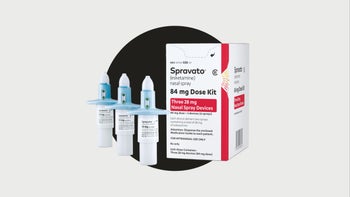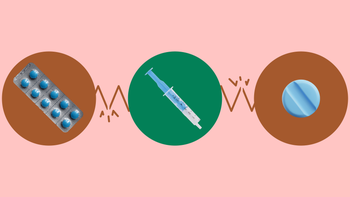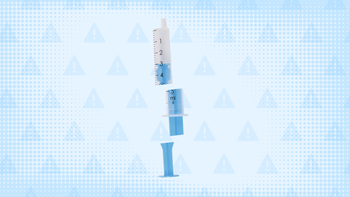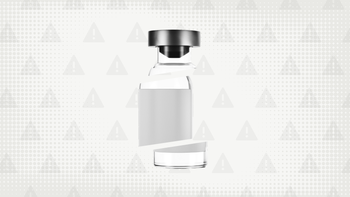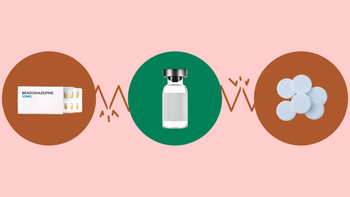
What Is Ketamine and How Is It Used To Treat Depression?
Key takeaways:
Ketamine was originally created for anesthesia during surgery. Though ketamine isn’t FDA approved for any mental health condition, it’s sometimes used off-label for severe or hard-to-treat depression.
Esketamine (Spravato), is an FDA-approved nasal spray for certain types of depression. It’s similar to ketamine, but works in a slightly different way.
Ketamine or esketamine should only be used in the presence of a healthcare professional. They can make sure it’s safe and monitor for any side effects that may occur.

Ketamine is a medication that’s been used for over 50 years as an anesthetic and pain killer. It’s also used illegally to get high.
But recently, ketamine — and its close cousin, esketamine (Spravato) — have gained attention for their use in treating depression and other mental health conditions. Ketamine seems to work very quickly, sometimes providing relief after just one dose. It may also help suicidal thoughts go away.
This is why ketamine may be a promising option for people with certain types of depression. Let’s learn how it works.
What is ketamine?
Ketamine was first created in the 1960s. It was approved for use during surgery as a part of anesthesia. At low doses, ketamine produces psychedelic effects similar to substances like LSD and psilocybin (the active ingredient in “magic mushrooms''). Ketamine can also make people feel disconnected or separated from their body.
Ketamine is classified as a Schedule III controlled substance. This means it has a potential for abuse or misuse. But it’s considered less harmful or addictive than Schedule I or II substances, like heroin or oxycodone.
Over time, ketamine use during surgery became less common. But more healthcare providers began using it off-label to treat pain. And with more widespread use, providers started noticing that ketamine also seemed to have antidepressant effects.
Read more like this
Explore these related articles, suggested for readers like you.
What is esketamine?
Esketamine (Spravato) is a nasal spray that’s FDA approved to treat:
Treatment-resistant depression
Depression with suicidal thoughts or actions
So how’s it different from ketamine? Ketamine is made up of two molecules that are mirror images of each other: (S)-ketamine and (R)-ketamine. But esketamine is only the (S)-ketamine molecule (hence the name). This molecule seems to be more potent than ketamine, with fewer side effects.
How do ketamine and esketamine work?
We don’t know exactly how ketamine and esketamine help with depression. They seem to act on many different parts of the brain, but experts still aren’t exactly sure which matters the most for depression.
Ketamine has effects on the following:
Glutamate: Ketamine affects glutamate activity in the brain. Glutamate is a chemical messenger that influences your mood, emotions, and the way you think.
Opioid receptors: Ketamine is not an opioid, but it affects the opioid system. The opioid system controls mood, reward/pleasure, and pain.
Neuroplasticity: Ketamine increases neuroplasticity. This is the brain’s ability to adapt to changes like learning, stress, or injury. Research shows connections between depression and lower neuroplasticity.
Default mode network (DMN): The DMN refers to parts of your brain that kick in when you’re awake but not active — like when you daydream. It may also be responsible for negative thoughts, especially about yourself. People with depression may have too much activity in their DMN. Ketamine has the ability to lower DMN activity in depressed people.
Esketamine works similarly to ketamine in the body. But it seems to do a better job of binding to glutamate receptors in your brain.
What is ketamine used to treat, and what does the research say?
Though ketamine is only FDA approved for use as an anesthetic, it’s also used off-label for treatment-resistant depression. Experts are also exploring the potential of ketamine therapy for several other mental health conditions, including:
Post-traumatic stress disorder (PTSD)
Depression
Ketamine’s quick antidepressant effects have been researched for decades. In 2000, the first human trial was conducted on ketamine for major depressive disorder. The results showed that ketamine infusions led to a significant improvement in symptoms.
In a study of over 500 people treated with ketamine for depression, more than 53% responded to treatment and 73% had a reduction in suicidal thoughts. Of those who responded, the improvements lasted up to 4 weeks for 80% of participants and up to 8 weeks for 60% of participants.
A benefit of ketamine treatment for depression is that it’s safe to keep taking most other antidepressant medications with it. Also, most FDA-approved antidepressant medications can take several weeks to start working. Ketamine seems to work much faster (within hours to days). But again, there’s still a lot about it we don’t know.
For example, we don’t know if ketamine’s psychedelic effects are necessary for its use as an antidepressant. More research is needed to find out exactly how ketamine works for depression.
Anxiety
Ketamine may cause anxiety for some people. But there’s also research on ketamine’s anti-anxiety effects. This could be an added benefit of ketamine, as many people with depression also have an anxiety disorder.
A review of the research concluded that ketamine may improve anxiety that hasn’t improved with other treatments. But more studies are needed to know for sure.
Post Traumatic Stress Disorder (PTSD)
PTSD is an illness that’s often caused by a traumatic or stressful event. It has many of the same symptoms as depression and anxiety. PTSD has also been linked to glutamate activity, reduced neuroplasticity, and abnormalities in the DMN. Experts believe that ketamine’s effects on these things could make it a helpful treatment option for PTSD.
But so far, studies on ketamine for PTSD symptoms have had mixed results. Ketamine may be more effective at treating chronic PTSD symptoms. One study showed that 67% of people with chronic PTSD responded to ketamine treatment.
Substance Use Disorders
Substance use disorders are one of the most pressing public health issues today, affecting over 20 million Americans over the age of 12. Ketamine has been studied for the treatment of certain substance use disorders.
People with alcohol use disorder saw 66% abstinence rates for up to 1 year after ketamine treatment. Research also showed a 67% reduction in cocaine use and up to 50% reduction in heroin use after three ketamine sessions. Much of the research found success when combining ketamine with psychotherapy.
Research also suggested that multiple ketamine treatment sessions may be more beneficial than a single treatment. The group treated for heroin use disorder saw a 22% reduction in use and cravings after one ketamine treatment session compared to a 50% reduction after three sessions.
What is esketamine used to treat?
Esketamine (Spravato) is FDA approved to treat treatment-resistant depression as well as depression with suicidal thoughts and behavior. So far, it doesn’t seem to be as effective as ketamine infusions for depression. But the nasal spray is easier to use and seems to have fewer side effects, which may make it a more attractive treatment option for some people.
How is ketamine administered for depression?
A healthcare provider can administer ketamine in several different ways. The different forms of ketamine include:
Intravenous infusion (IV)
Injection into the muscle (IM)
Injection under the skin
Oral or sublingual tablet
Ketamine given as an IV has the most research behind it. The IM injection is often reserved for emergency situations involving suicidal actions. Oral ketamine isn’t absorbed well, so the effects are more subtle. It’s usually prescribed to take at home between infusion treatments.
What is microdosing — and how is it different?
Microdosing refers to the practice of taking very small doses of a psychedelic substance. These doses are meant to be small enough to avoid severe psychedelic effects but still offer some potential benefits. But more research is needed, as most microdosing “evidence” is self-reported, and many of these claims have not been proven in human studies.
It isn’t considered microdosing when you receive ketamine treatment for depression. Depression treatment requires a lower dose than anesthesia, but it’s still high enough to cause psychedelic effects. More research is being done to see if microdoses of ketamine may be effective for depression.
What are the side effects of ketamine and esketamine?
The risk and severity of ketamine and esketamine side effects might depend on the dose and how often you take it. But it’s hard to say for sure, especially since ketamine is used off-label — meaning side effects aren’t as closely monitored as with an FDA-approved medication like Spravato.
• Dissociation, hallucinations, changes in perception • Elevated mood • Anxiety or fear • Nausea, vomiting • Dizziness • Loss of coordination and balance • Confusion or disorientation • Blurred vision • Muscle stiffness or spasms • Fast heart rate • High blood pressure | • Anxiety • Drowsiness • Nausea and vomiting • Dizziness or vertigo • Distorted sense of time and space • High blood pressure • Confusion • Impaired ability to drive or operate machinery • Pain when peeing |
More serious ketamine side effects can also occur, but they’re more common with higher doses of ketamine or an IV infusion that’s given too fast. These include:
Difficulty breathing
Slow heart rate
Seizures
Coma
Is it safe to use ketamine or esketamine over a long period of time?
We don’t know yet. There’s not enough evidence to say whether it’s safe to use ketamine or esketamine long-term for depression.
So far, there’s evidence that esketamine is safe to use for up to 1 year. But the long-term risks aren’t as clear with ketamine. There’s some evidence ketamine use over time could damage your kidneys, bladder, or brain. More research is needed to know for sure.
Do ketamine or esketamine interact with other medications?
Yes. Ketamine and esketamine have possible drug interactions to consider.
Esketamine can interact with the following medications:
Central nervous system (CNS) depressants, such as benzodiazepines, opioids, and alcohol. If they’re combined with esketamine, your breathing could become dangerously slow.
Stimulants, such as methylphenidate (Ritalin) or modafinil (Provigil). If these medications are combined with esketamine, it could cause a severe increase in blood pressure or heart rate, which could be life-threatening.
Monoamine Oxidase Inhibitors (MAOIs). MAOIs are a class of medications that treat depression. Most antidepressant medications are safe to take with esketamine. But combining it with MAOIs can increase blood pressure and heart rate.
There’s less information available on ketamine drug interactions. CNS depressants and stimulants likely interact with ketamine the same way as esketamine. Benzodiazepines, lamotrigine (Lamictal), and certain antipsychotic medications may make ketamine less effective, but the evidence isn’t strong.
The lack of good information on drug interactions highlights the importance of taking ketamine while under the care of a medical professional. They’re able to monitor for any signs of an interaction and help manage it. Be sure to keep a medication list and show it to your provider prior to starting ketamine or esketamine treatment.
How do I know if ketamine or esketamine are right for me?
In most cases, ketamine and esketamine are not the first choice to treat depression or other mental health conditions. But if your depression symptoms are severe, or if you’ve tried and failed with other treatments, ketamine or esketamine may be an option for you.
Keep in mind that you shouldn’t try to self-treat with ketamine or esketamine. There are health conditions and medications that could make these medications unsafe for you. Ketamine or esketamine should only be used under the guidance of a healthcare professional.
The best first step is to talk to your mental healthcare provider about whether ketamine or esketamine are an option for you.
Who should not take ketamine or esketamine?
Ketamine may not be safe to take if you have certain conditions, such as:
Pregnant or nursing
High or unstable blood pressure
Liver problems
Schizophrenia
Alcohol intoxication
You should not take esketamine if you:
Have a history or bleeding in the brain
Have an aneurysm or blood vessel disease
The bottom line
Ketamine and esketamine (Spravato) are gaining attention as a fast-acting treatment for severe or hard-to-treat depression. Only Spravato, a nasal spray that’s similar to ketamine, is FDA approved for certain types of depression. Like most medications, ketamine and esketamine have side effects and drug interactions to be aware of. Because of these, these medications should only be used in the presence of a medical professional.
Why trust our experts?



References
Abdallah, C. G., et al. (2018). The effects of ketamine on prefrontal glutamate neurotransmission in healthy and depressed subjects. Neuropsychopharmacology.
Ahuja, S., et al. (2022). Real-world depression, anxiety and safety outcomes of intramuscular ketamine treatment: A retrospective descriptive cohort study. BMC Psychiatry.
Akiki, T. J., et al. (2018). Default mode network abnormalities in posttraumatic stress disorder: A novel network-restricted topology approach. NeuroImage.
Al-Hasani, R., et al. (2011). Molecular mechanisms of opioid receptor-dependent signaling and behavior. Anesthesiology.
An, D., et al. (2021). Intranasal ketamine for depression in adults: A systematic review and meta-analysis of randomized, double-blind, placebo-controlled trials. Frontiers in Psychology.
Anderson, D. J., et al. (2022). Ketamine-induced cystitis: A comprehensive review of the urologic effects of this psychoactive drug. Health Psychology Research.
Bahji, A., et al. (2021). Comparative efficacy of racemic ketamine and esketamine for depression: A systematic review and meta-analysis. Journal of Affective Disorders.
Bahr, R., et al. (2019). Intranasal esketamine (Spravato) for use in treatment-resistant depression in conjunction with an oral antidepressant. Pharmacy and Therapeutics.
Bell, R. F., et al. (2018). Ketamine for pain management. PAIN Reports.
Berman, R. M., et al. (2000). Antidepressant effects of ketamine in depressed patients. Biological Psychiatry.
Bowdle, A., et al. (1998) Psychedelic effects of ketamine in healthy volunteers: Relationship to steady-state plasma concentrations. Anesthesiology.
Buckner, R. L. (2013). The brain's default network: Origins and implications for the study of psychosis. Dialogues in Clinical Neuroscience.
Cavenaghi, V. B., et al. (2021). Subcutaneous ketamine in depression: A systematic review. Frontiers in Psychiatry.
Chilukuri, H., et al. (2014). Acute antidepressant effects of intramuscular versus intravenous ketamine. Indian Journal of Psychological Medicine.
Dakwar, E., et al. (2017). Cocaine self-administration disrupted by the N-methyl-D-aspartate receptor antagonist ketamine: A randomized, crossover trial. Molecular Psychiatry.
Domino, E., et al. (1965), Pharmacologic effects of CI-581, a new dissociative anesthetic, in man. Clinical Pharmacology & Therapeutics.
Du, R., et al. (2022) The multivariate effect of ketamine on PTSD: Systematic review and meta-analysis. Frontiers in Psychiatry.
Evans, J., et al. (2018). Default mode connectivity in major depressive disorder measured up to 10 days after ketamine administration. Biological Psychiatry.
Feder, A., et al. (2021). A randomized controlled trial of repeated ketamine administration for chronic posttraumatic stress disorder. American Journal of Psychiatry.
Gland Pharma Limited. (2023). Ketamine hydrochloride [package insert].
Guimarães, D., et al. (2020). Neuroplasticity: The brain changes over time! Frontiers for Young Minds.
Hamilton, J. P., et al. (2015). Depressive rumination, the default-mode network, and the dark matter of clinical neuroscience. Biological Psychiatry.
Janssen Pharmaceuticals. (2020). Spravato [package insert].
Jelen, L. A., et al. (2020). Ketamine: A tale of two enantiomers.
Jones, J., et al. (2018) Efficacy of ketamine in the treatment of substance use disorders: A systematic review. Frontiers in Psychiatry.
Kohtala, S. (2021). Ketamine–50 years in use: From anesthesia to rapid antidepressant effect and neurobiological mechanisms. Pharmacological Reports.
Krupitsky, E. M., et al. (1997). Ketamine psychedelic therapy (KPT): A review of the results of ten years of research. Journal of Psychoactive Drugs.
Krupitsky, E. M., et al. (2007). Single versus repeated sessions of ketamine-assisted psychotherapy for people with heroin dependence. Journal of Psychoactive Drugs.
Krystal, J., et al. (2017). Synaptic loss and the pathophysiology of PTSD: Implications for ketamine as a prototype novel therapeutic. Current Psychiatry Reports.
Kurdi, M. S., et al. (2014). Ketamine: Current applications in anesthesia, pain, and critical care. Anesthesia, Essays and Researches.
Le Merrer, J., et al. (2009). Reward processing by the opioid system in the brain. Physiological Reviews.
Li, L., et al. (2016). Ketamine: 50 years of modulating the mind. Frontiers in Human Neuroscience.
Liriano, F., et al. (2019). Ketamine as treatment for post-traumatic stress disorder: A review. Drugs in Context.
Luckenbaugh, D., et al. (2014). Do the dissociative side effects of ketamine mediate its antidepressant effects?. Journal of Affective Disorders.
Matveychuk, D., et al. (2020). Ketamine as an antidepressant: Overview of its mechanisms of action and potential predictive biomarkers. Therapeutic Advances in Psychopharmacology.
McInnes, L. A., et al. (2022). A retrospective analysis of ketamine intravenous therapy for depression in real-world care settings. Journal of Affective Disorders.
McIntyre, R. S., et al. (2021). Synthesizing the evidence for ketamine and esketamine in treatment-resistant depression: An international expert opinion on the available evidence and implementation. The American Journal of Psychiatry in Advance.
National Center for Drug Abuse Statistics. (n.d.). Drug abuse statistics.
Nummenmaa, L., et al. (2018). Opioid system and human emotions. British Journal of Pharmacology.
Orhurhu V. J., et al. (2022). Ketamine toxicity. StatPearls.
Pal, M. (2021). Glutamate: The master neurotransmitter and its implications in chronic stress and mood disorders. Frontiers in Human Neuroscience.
Pittenger, C., et al. (2008). Stress, depression, and neuroplasticity: A convergence of mechanisms. Neuropsychopharmacology.
Polito, V., et al. (2022) The emerging science of microdosing: A systematic review of research on low dose psychedelics (1955–2021) and recommendations for the field. Neuroscience & Biobehavioral Reviews.
Rosenbaum S. B., et al. (2022) Ketamine. StatPearls.
Schoevers, R. A., et al (2016). Oral ketamine for the treatment of pain and treatment-resistant depression. British Journal of Psychiatry.
Thase, M., et al. (2023). Ketamine and esketamine for treating unipolar depression in adults: Administration, efficacy, and adverse effects. UpToDate.
Tuck, A., et al. (2017). Ketamine as a rapid-acting antidepressant: Pomising clinical and basic research. American Journal of Psychiatry.
U.S. Food and Drug Administration. (2019). FDA approves new nasal spray medication for treatment-resistant depression; available only at a certified doctor’s office or clinic.
United States Drug Enforcement Administration. (2018). Drug scheduling.
Veraart, J. K. E., et al. (2021). Pharmacodynamic interactions between ketamine and psychiatric medications used in the treatment of depression: A systematic review. International Journal of Neuropsychopharmacology.
Whittaker, E., et al. (2021). Systematic review and meta-analysis of randomized controlled trials of ketamine in the treatment of refractory anxiety spectrum disorders. Therapeutic Advances in Psychopharmacology.
Williams, N. R., et al. (2018). Opioid receptor antagonism attenuates antidepressant effects of ketamine. The American Journal of Psychiatry.
Wu, H., et al. (2021). Ketamine for a boost of neural plasticity: How, but also when? Biological Psychiatry.
Zyck, S., et al. (2022). Arteriovenous malformations. StatPearls.
Keep in mind that psilocybin is legal in some states for personal and/or medicinal use, but not in others. Psilocybin is still illegal under federal law.






